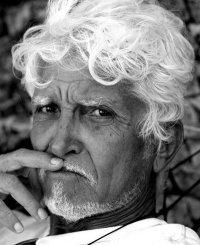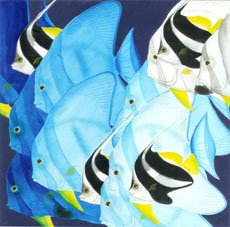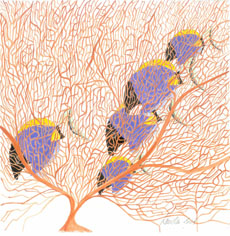Prominent Chinese artist Yuan Xikun says that during the tumultuous times of the Cultural Revolution, “to escape the meaningless fight between people” he went off and lived in the wilderness like Robinson Crusoe.
Even though he had been selected to stay in the city to paint the portrait of Chairman Mao Zedong, Xikun requested to be sent off to rural Xishungbanna. Life in the wilderness provided fodder for his paintings. In particular an encounter with a tiger at close range had a major impact on him, influencing his art.
His paintings of tigers are many; specially striking is one titled ‘Mountain Gentleman’ of a tiger’s unflinching stare in an Oriental Canvas.
“When I came across it in the forest it became a staring match and then luckily it walked away,” says Xikun, speaking through a translator at a talk he gave Monday night at the National Art Gallery. The new Chinese Ambassador to Maldives Yu Hongyao and Deputy Minister of Tourism, Arts & Culture Mamduh Waheed attended the talk along with Maldivian artists.
The tiger connection
Eleven paintings by Xikun, of tigers in various poses, were on display at the art gallery. One of a small Chinese boy next to a docile tiger lying on its paws is aptly titled ‘Tiger tamed by boy with magic powers.’ The magnificent creature evokes sympathy in the viewer in the painting titled ‘Waiting for home’ a forlorn tiger seen through the bars of its cage.
The tiger is also what has lead Xikun to come to Maldives. Xikun, who is also a world-renowned sculptor, is the United Nations Environment Programme (UNEP)’s Patron for the Environment and Arts. UNEP uses Xikun’s sculptures for its environmental Champions of the Earth trophies – one of which was received by President Mohamed Nasheed.
A keen environmentalist, Xikun says it was inspiring to see the President doing something about carbon emissions.
A tall striking figure, Xikun took the attendees through his work via a power point presentation while talking animatedly in Chinese.
“You might ask why bring paintings of tigers to an Oceanic country. The thing is sharks share a similar destiny to tigers in the environment.” Xikun regularly uses his art to highlight threats to the environment and remind the viewers that the Earth’s resources are finite.
A miniature of his famous sculpture, ‘Urgency of the polar region’ was also on display. The sculpture of a mother polar bear balancing a top an iceberg with its two young cubs clinging to its side highlights the dangers of the melting icebergs.
“Religion and art are all connected to nature, this earth and its biodiversity is not an inheritance of our forefathers but is borrowed from our offspring,” said Xikun, and reiterated his call “for all human beings to achieve supreme kindness and to live in harmony with nature.”
A project
Xikun says it is in recent years environmental awareness has become such a large part of his philosophy infusing his work. Though his interest in painting ink wash portrait of foreign dignitaries and leaders had also earned him the title of ‘portrait diplomat’. So far he has painted over 152 portraits including that of Nelson Mandela.
His sculptures have often been presented as national gifts by the Chinese government to other countries. Notable among them is a gift to America, the sculpture of former president Abraham Lincoln, titled ‘Before the Decisive Battle-Lincoln.’
He has also produced sculptures of Einstein and Gandhi, along with 158 world leaders in politics and arts. Xikun is also the founder and curator of the first private museum in China, the Jin Tai Art Museum in Beijing.
A firm believer of cultural exchange, Xikun says “we are all live under one common sky and we will all face the environmental crisis, so I hope one day there is a mass movement for environmental protection.”
Xikun is gifting the three miniature sculptures he brought to Maldives. Among them is one titled ‘Sky patch.’ After the talk he explained that the sculpture of a woman carrying a rectangle block in her outstretched arms had originated from a Chinese myth about a goddess that blocks a hole in the earth.
“This is relevant to today’s times because we have a desire to do something about the environmental problems we face.” The other sculpture is that of Napoleon holding on to St Helena.
Plans are on to collect sand from five continents and water from the two Arctic Poles to do a giant sculpture of ‘Sky patch.’
Xikun will meet the President on on Wednesday, to discuss the project and gift the sculptures. Xikun extended an invitation to everyone to “come for the sand collection, to be part of the sculpture project.”


